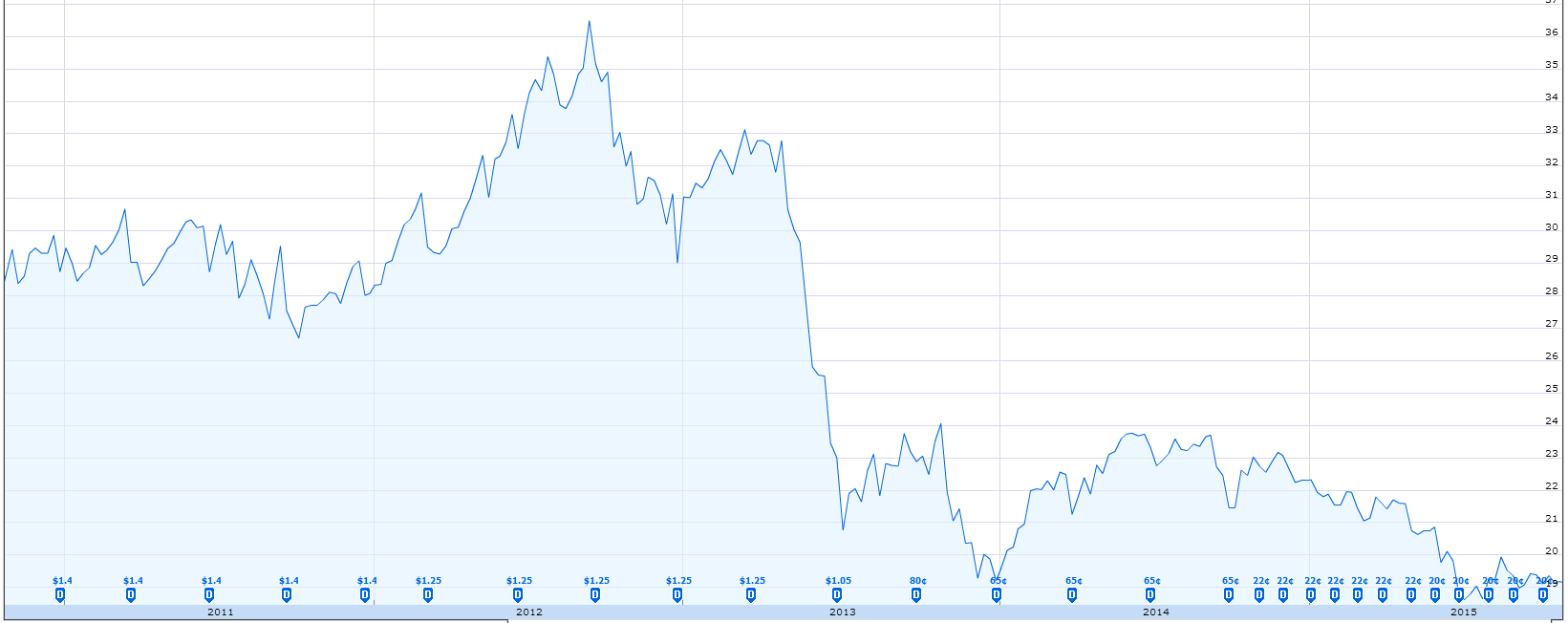3 Popular High-Yield REITs About To Cut Dividends 40% Or More
They are part of a very popular subset of the REIT sector and their over 10% yields may have convinced you to invest, but their businesses are about to come under serious pressure. The last time this happened dividends were cut by 40% or higher and their share prices tanked.
I have been invited by Bloomberg to participate next month in a panel discussion concerning the effect of higher interest rates on investment decisions. While the actual implementation of a rate increase by the Fed continues to get pushed out into the future, there is one type of high yield stock that will be very negatively affected by a higher interest rate environment. Before we dig into what not to own, I want to make clear that I think that a dividend-focused investment strategy has a good chance of significant out-performance over the market for the next few years and even the decade.
The finance real estate investment trusts (REITs) carry some of the highest yields of any investment category. The iShares Mortgage Real Estate Capped ETF (NYSE:REM) is the most popular ETF covering the finance/mortgage REITs, and REM currently yields 14%. This makes the stocks in this REIT subsector naturally attractive to many investors, either those who need income from their portfolios or those who want to reinvest those dividends to buy more shares and build a growing income stream. The market lumps the finance/mortgage REITs all together, and they tend to move up and down as a group. However, this subsector can be divided into two distinct types of business models, one that can generate a high-yield and growing cash dividend stream in your portfolio and one that will destroy wealth, especially in a rising interest rate scenario. Fortunately, there are just a couple of clues that allow you to determine which category a specific finance REIT falls into.
The dangerous mortgage REITs invest in the safe, U.S. government agency guaranteed mortgage-backed securities (MBS). The challenge for one of these REITs is that agency MBS yield about 2.5%, so the business model requires the use of massive levels of leverage to bring earnings up to a point where the company can pay dividends to support a 10%+ yield. Leverage of 5 to 8 times equity is common, with a mortgage REIT borrowing money in the short-term space to buy long-term MBS, generating a yield spread between the short and long rates. When short-term rates increase, the spread narrows forcing a reduction in dividends. Rising long-term rates reduce the market value of a REIT’s MBS holdings resulting in a falling book value and forced selling of assets as leverage rises due to lower asset values. The effects of rising rates was graphically illustrated in early 2013, when mortgage rates increased by about 1%. This modest rate increase resulted in 40% reductions in both dividend rates and share prices. These REITs have not recovered since. The next interest rate hike will repeat the pattern, destroying investor wealth.
Here is the five-year chart with dividends from American Capital Agency Corp. (NASDAQ:AGNC), one of the largest agency MBS REITs that shows how much a rate increase hurts values and the inability of this business model to recover lost value.

The management teams of these companies say that they can minimize the risks using hedging strategies. Their 2013 results show how well that works. As we have learned from market crashes in several sectors, hedging does not protect profits, it just keeps companies from going out of business. Two other widely owned mortgage REITs to avoid or sell are Annaly Capital Management (NYSE:NLY) and Two Harbors Investment Corp (NYSE:TWO).
The primary characteristic of the good type of finance REIT is that they have real businesses, making loans and earning interest on those loans. These REITs primarily provide commercial mortgages, which have shorter five to seven year terms. A lending REIT will use a modest level of leverage to boost the returns on invested equity. These companies tend to grow their businesses, looking for more lending opportunities that will increase revenues and cash to pay dividends. Unlike the agency mortgage REITs, which are slashing dividend rates, the commercial mortgage REITs have been increasing dividends. The bottom line is that these companies are real businesses, while the MBS REITs are nothing more than dangerously leveraged portfolios of mortgage securities. A couple of commercially focused finance REITs that have increased dividends nicely over the last year and should continue to do so are Blackstone Mortgage Trust (NYSE:BXMT) and Hannon Armstrong Sustainable Infrastructure Capital (NYSE:HASI).
So as you look for high-yield opportunities in the finance REIT sector, ask whether a specific company is a real business or just a highly leveraged portfolio of marketable mortgage securities. Invest in the former, sell the latter.
Finding companies that regularly increase their dividends is the strategy that I use myself to produce superior results, no matter if the market moves up or down in the shorter term. The combination of a high yield and consistent dividend growth in stocks is what has given me the most consistent gains out of any strategy that I have tried.
Disclosure: more



